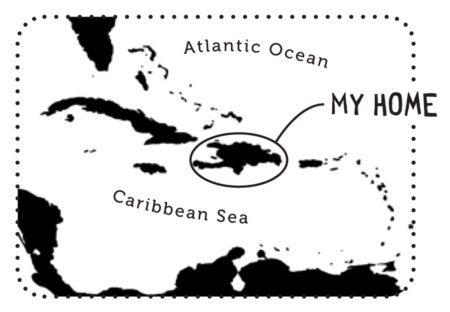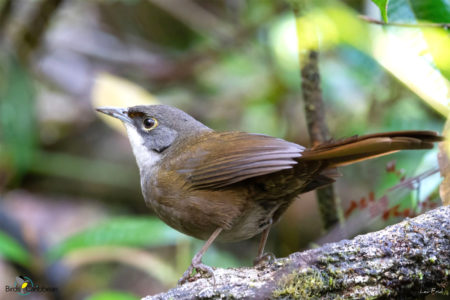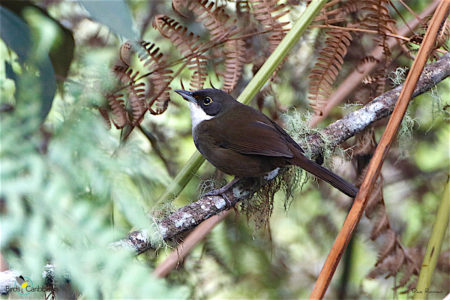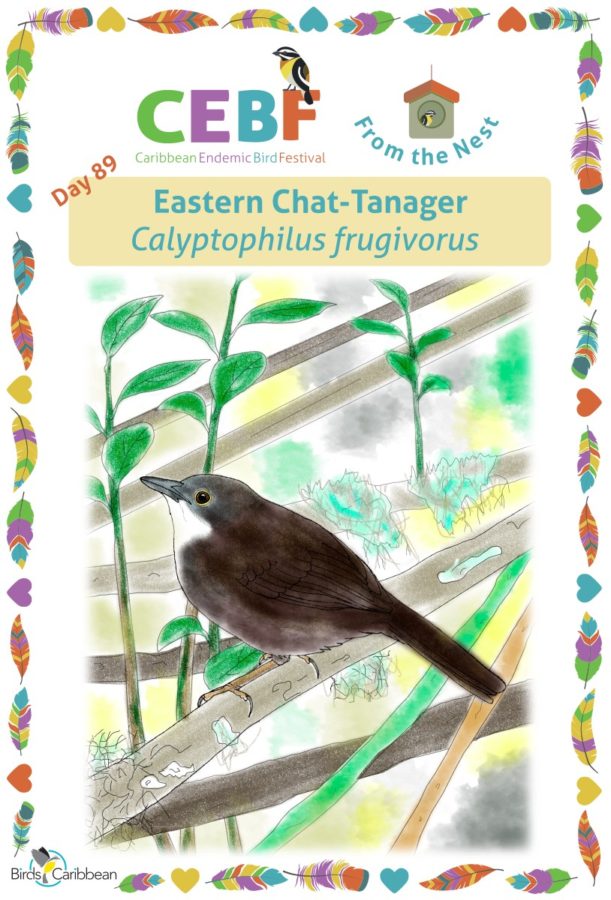Celebrate the Caribbean Endemic Bird Festival (CEBF) with us! Our theme in 2022 is “Loving Birds is Human Nature”. Have fun learning about a new endemic bird every day. We have colouring pages, puzzles, activities, and more. Download for free and enjoy nature with your family at home.
Endemic Bird of the Day: Eastern Chat-Tanager
 If you find yourself birding on the high elevation mountain forests of Cordillera Central, Sierra de Neiba, and Bahoruco Oriental, on the island of Hispaniola, keep an eye out for the elusive Eastern Chat-Tanager! It is a shy, ground-dwelling bird that can be hard to see, but easily heard singing at dawn.
If you find yourself birding on the high elevation mountain forests of Cordillera Central, Sierra de Neiba, and Bahoruco Oriental, on the island of Hispaniola, keep an eye out for the elusive Eastern Chat-Tanager! It is a shy, ground-dwelling bird that can be hard to see, but easily heard singing at dawn.
The Eastern Chat-Tanager is a medium size bird, a bit smaller than a Mockingbird, with a long tail and strong long legs and feet. It is dark olive-brown above, with a white throat and grayish underparts, yellow eyering, and a spot of yellow at the bend of the wings, which is hardly seen. It often sings from a low perch within dense vegetation – an emphatic, clear whistling “chip-chip-swep-swep-swep” or “chirri-chirri-chirri-chip-chip-chip,” repeated many times.
Eastern Chat-Tanagers are usually seen in pairs, foraging on or near the ground, searching through the leaf litter. They feed primarily on insects and small invertebrates, and a small amount of fruit. This species is often observed flying short distances, close to the ground, across a narrow path or trail, from one patch of vegetation to an adjacent one.
Endemic to the island of Hispaniola, the Eastern Chat-Tanager is quite a unique bird. It belongs to the Caribbean endemic bird family, Calyptophilidae, from the Greek word Calyptophilus (“loving to hide”). There are three (3) recognized subspecies. Information on the Eastern Chat-Tanager is limited, due to its secretive nature and hard to navigate habitat. To date, only one nest has been described and published.
The Eastern Chat-Tanager is uncommon on Hispaniola with a limited distribution. Its conservation status is considered to be Near Threatened by the IUCN, due to habitat fragmentation and destruction—mostly from uncontrolled logging and the clearing of forests for agriculture. Learn more about this species, including its range, photos, and calls here.
Colour in the Eastern Chat-Tanager
Download our West Indies Endemic Bird colouring page. Use the photos below as your guide, or you can look up pictures of the bird online or in a bird field guide if you have one. Share your coloured-in page with us by posting it online and tagging us @BirdsCaribbean #CEBFfromthenest
Listen to the song of the Eastern Chat-Tanager
The song of the Eastern Chat-Tanager is a whistled and sometimes variable “weet-weet-werp chip-cheep-sweet…” which can end with a short trill.
Puzzle of the Day
Click on the image below to do the puzzle. You can make the puzzle as easy or as hard as you like – for example, 6, 8, or 12 pieces for young children, all the way up to 1,024 pieces for those that are up for a challenge!


Activity of the Day
 FOR KIDS: Eastern Chat-Tanagers are shy and secretive birds. They spend a lot of their time looking for yummy worms and other tasty insects on the ground, amongst the dense forest vegetation. Their colours also make them blend in with their surroundings. All of this means that these birds are really hard to find in the forest! Can you spot all 15 hiding Eastern Chat-Tanagers? When you think you have found them all, check the answers here.
FOR KIDS: Eastern Chat-Tanagers are shy and secretive birds. They spend a lot of their time looking for yummy worms and other tasty insects on the ground, amongst the dense forest vegetation. Their colours also make them blend in with their surroundings. All of this means that these birds are really hard to find in the forest! Can you spot all 15 hiding Eastern Chat-Tanagers? When you think you have found them all, check the answers here.
FOR KIDS AND ADULTS: These birds are hard to spot but you can enjoy this short video below and get a glimpse of an Eastern Chat-Tanager in the wild!
The Eastern Chat-Tanager was one of several Caribbean endemic birds spotted by participants during our recent landbird monitoring workshop, held in the Dominican Republic! In February 2022 we brought in 26 participants and 8 workshop leaders representing a total of 16 countries to immerse themselves in landbird monitoring methods! We chose the scenic valley of Jarabacoa known for its stunning landscapes and birds. From the classroom to the forest, the workshop provided participants with the knowledge and confidence to train a monitoring team and institute a sustainable, local landbird monitoring program in their home countries using the Programa de América Latina para las Aves Silvestres (PROALAS) Manual and bird survey protocols. Find out more about this fantastic and exciting workshop, and our landbird monitoring program below.

